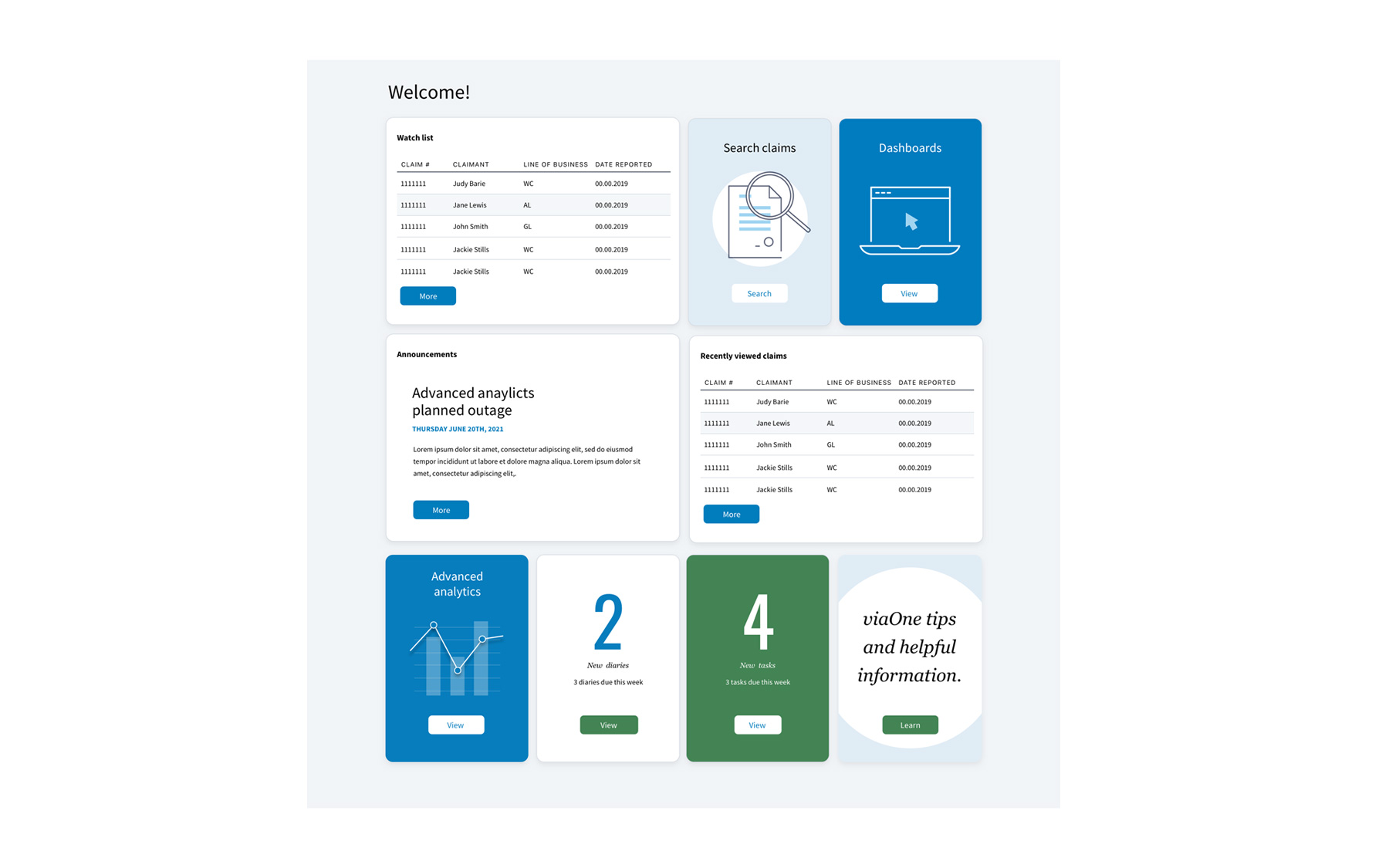Short takes on industry trends, emerging issues and new technology enhancements
New viaOne dashboard options enhance data experience
ViaOne, our digital client experience for real-time claims information, now includes enhanced dashboard capabilities that offer new and improved data visualization. Clients can determine the path and depth of data they see, and toggle from the aggregate, graphical view down to the individual claim level. They can select from a catalog of tables, charts and graphs to build personalized dashboards with the information they need, when they need it.
Our latest enhancement builds upon the extensive features already in viaOne. Through a secure website, users can track and analyze key claims and absence metrics, run standard and custom reports, set alerts, and generate powerful loss triangles to support actuarial analyses. The system provides clients with 24/7 access and integrates with virtually any human resources, risk management or payroll system.
ViaOne offers unique views for different audiences and visualizes data across multiple lines of business including workers’ compensation, managed care, disability and absence, liability and property. Users also have full visibility into every aspect of managed care, from triage and intake to clinical services and medical bill review. And viaOne is the only fully integrated OSHA solution in the industry.
Sedgwick’s technology is built around advanced market-facing claims tools that support every aspect of our services, making the client and consumer the focus at every step. Additional tools include smart.ly, our flexible intake and incident management platform, and mySedgwick, our self-service tool.
Designed to address a range of high-volume incidents or claims events, smart.ly integrates advanced technology — including real-time system interactions, artificial intelligence, optical image analysis and intuitive scripts — behind the scenes to simplify the intake process. Multilingual and available to deploy anywhere in the world, smart.ly can address a wide range of scenarios. See our smart.ly update in the last issue of edge.
MySedgwick uses role-based access to give clients, their employees, consumers and insureds rapid access to loss and claims data. With this self-service tool, claims and absence reporting, provider search and document upload are simplified; the user experience is supported through communication options, payment updates and more. Features are tailored by line of business — intake options are available for workers’ compensation, disability, leave, property, and general and auto liability claims.
___________
See “Cultivating the ultimate consumer experience” in this issue to read more about how our technology focuses on supporting people throughout the process.
Sedgwick’s technology platforms were developed based on our experience with clients in all industries across multiple lines of business. To learn more about all of our technology solutions, see sedgwick.com/solutions/technology.
Product safety report highlights the latest trends and challenges
BY CHRIS HARVEY
senior vice president, client services, Sedgwick
Our 2022 Recall Index report, published earlier this year, takes a close look at the economic, regulatory and legal challenges facing several industries including automotive, consumer product, food and drink, pharmaceutical and medical device. This edition shares the biggest product quality and safety risks from 2021, and why average recall sizes are at their highest level in over a decade.
Sedgwick’s recall index report offers a fundamental resource for manufacturers and retailers seeking impartial, reliable analysis and perspective on product safety regulations and trends. It also aggregates and tracks essential sector data to help stakeholders mitigate litigation and reputational damage caused by recalls and other in-market product incidents.
Key topics include:
- Factors that made 2021 a huge year for U.S. recalls, with more than 1 billion units recalled
- Top causes of recalls across five key industries
- Top product safety priorities for the CPSC, FDA, NHTSA and USDA
- Best practices for navigating the current business and regulatory environment
- Top recall data and trends in 2021 and predictions
for 2022
U.S. and European editions are available. Click here to learn more and download a copy.
Sedgwick provides a wide range of brand protection solutions to assist clients with product recalls, remediation and customer retention. To learn more about these services, visit our website.
View 22: Focusing on people, property, brands and performance
Earlier this year, we introduced our View 22 list, highlighting trends and topics that employers, risk management and human resource professionals, brokers and carriers should watch throughout the year. Sedgwick’s industry experts and thought leaders focused on 22 key trends we believe are essential to follow this year. They align with our view on people, property, brands and performance:
View on people
Organizations around the world face workforce challenges, populations moving beyond a pandemic mindset and, as a result, reshaping their attitudes toward work, benefits and balance. In the face of ongoing change, partnership and support will be essential to organizations’ success and the overall health and wellness of their teams.
View on property
Supply chain disruption, fluctuation in labor and demand, and ever-shifting restrictions have created both shortages and surges in the marketplace – this will impact all types of property claims and repairs. As technology and the global landscape influence the way we respond, what changes will we see in coverage, service and resolution?
View on brands
Companies across all industries face new levels of risk and ongoing pressure in approaching regulation, liability and reputation. Proactive preparation can make a critical difference in getting ahead of the next product or brand crisis.
View on performance
Data science and advanced analytics are driving the technological transformation of organizations, helping leaders leverage insights and maintain business continuity. But partnership remains a differentiating factor as organizations adapt to evolving models, improve consumer experience and transform for the future.
Take a closer look
As we monitor these issues and their impact on our industry, we will continue to share strategies and solutions to help meet the challenges. Read the full View 22 list at sedgwick.com/view22. For our broader industry thought leadership, visit our website and follow Sedgwick’s news at sedgwick.com/news.
Work from home, vaccine and litigation trends in 2022
BY ADAM MORELL
JD, assistant vice president, product compliance, Sedgwick
The crystal ball for the remainder of 2022 shows us that trends around work from home, vaccine mandates and litigation are sure to evolve. How can employers prepare?
Work from home: a game changer for employees with a disability
Before the pandemic, it was generally accepted for a court to defer to an employer on whether onsite presence was an essential function of the job. Therefore, they frequently didn’t have to grant remote work as an accommodation. However, after nearly two years of working remotely, questions will arise about why employees with a disability cannot continue to do so.
Moving forward, employers who want to decline requests from employees to work from home will need to individually assess each circumstance and pinpoint why remote work was not effective in the early stages of the pandemic. This could involve problems with technology, decreased productivity, lost sales, etc. Fortunately, as the cases of Frantti v. State of New York (2nd Cir. 2021) and Ryerson v. Jefferson County (11th Cir. 2021) illustrate, if you have a strong interactive dialogue with the employee and you determine that working from home isn’t reasonable, you will be in a much better position declining the request than if you didn’t do the individualized assessment.
Vaccine mandates: keeping up with evolving regulations
With the shelving of the proposed Occupational Health and Safety Administration (OSHA) temporary standard, state and local vaccine mandates will likely continue to pop up as the OSHA rule makes its way through the courts. Currently, nearly two dozen states have some kind of vaccine or test requirement.
On the other side of the coin, nearly a dozen states have adopted new laws intended to curtail workplace vaccine mandates. In fact, a couple of states, including Montana and Tennessee, have sought to ban such mandates entirely. Familiarizing yourself with evolving state and local regulations is essential.
At the employer level, many companies have implemented their own vaccine mandates. Equal Employment Opportunity (EEO) laws allow an employer to require all employees physically entering the workplace to be fully vaccinated against COVID-19, subject to the reasonable accommodation provisions of the Americans with Disabilities Act (ADA), Title VII, and other EEO considerations.
While several high-profile companies have issued strict vaccine mandates, the tight labor market may prevent some companies from doing the same. In fact, two of the country’s biggest manufacturers dropped their proposed vaccination requirements in December 2021 and another food and beverage company reversed course – informing employees that it would not require any vaccine or testing regimen.
Litigation expectations for 2022
In 2019, for the first time in the history of the ADA, disability charges were filed more frequently than any other type: race, color, religion, sex, national origin or age. In 2020, that trend continued, and the gap between disability charges and other charges widened. Aided by claims related to COVID-19, we anticipate that when litigation statistics for 2021 are announced, the trend will continue and the gap between disability and everything else will expand.
This article recently appeared on the Sedgwick Connection blog. Click here to read more. Visit our website for the latest blogs on work from home, vaccines and litigation.




